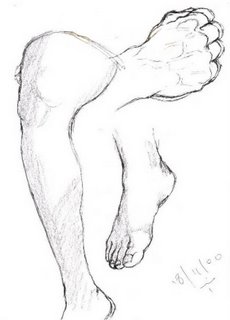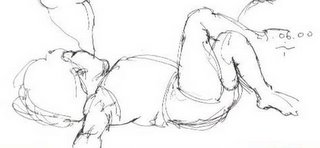This is a series on my watercolour works:
 Study on Capsicums - "In Dialogue"
Study on Capsicums - "In Dialogue"
I can still remember in the year 1984, I got a chance to first learn watercolour painting in my first year Foundation in Nanyang Academy of Fine Arts. Mr Tan, my lecturer, taught me how to mix colours to enrich my paintings, making them more 'colour-rich'. This skill has made my NAFA works look very different from my watercolour days in secondary school - where the colours looked comparatively boring and dull then...
During my early NAFA days, my fellow classmates supported my painting ability in class. They commented on my watercolours like: "Shih Yaw can control water very well", and "Shih Yaw has his own painting style even though he is very young"... They had also encouraged me as my colour-mixing improved along the way. All these comments made me feel very happy.
 Study on capsicums - "Out of Dialogue"
Study on capsicums - "Out of Dialogue" In the above painting, the 'one-layer' technique I learnt from Mr Wee
can be seen in the painting of the green pepper.
Sometime later, I chanced upon a School Teachers Training Class conducted in our campus. I witnessed our another lecturer, Mr Wee, demostrate on watercolour painting and I was surprised to see that he only used one layer of paint. What I was impressed to see, however, was that in that one layer, he was able to bring out both the dark and light tones. It was seldom to see him painting on a second layer.
From that day onwards, I marked Mr Wee's teaching class on my timetable. Every week I would stand outside his classroom, looking through the window, trying my best to learn his technique. Back in my own art class, I tried his technique in my work. Slowly, I became aware that I was able to catch some of his techniques and this marked a further improvement in my paintings.

Study on Salmon Head, view 1
After a few months, I finished the first half-year of my Foundation course. From the watercolour medium, my class progressed on to oil-painting. This progressing into another class meant that Mr Tan no longer taught me watercolour-painting; it also meant that I was unable to do watercolour as often as before.
Summing up, Mr Tan- his rich colour-mixing, and Mr Wee - his 'one-layer complete technique' have nevertheless influenced my watercolouring skills alot.
Continuing in NAFA, I spent more time doing oil-painting in my school projects. I also spent a lot of time on portrait-drawing, leaving my watercolour-painting to take a backseat, only doing it now and then for leisure; sometimes did try to push my skills to another level, but at other times, I just enjoyed looking at two or more colours mixed directly on paper.

Study on Salmon Head - view 2
Throughout my 3 years at NAFA, I did a lot of oil-painting for my own development, and it has since been my main medium. However, when it comes to teaching students, I always use watercolour as a medium. I think it is because for oil-painting, materials are expensive and not many students can afford it. In oil-painting, we also need to use turpentine which would smell. Thus, I feel more comfortable to teach them in watercolour, and the students also prefer that. However in teaching, I only teach the most basic skills.
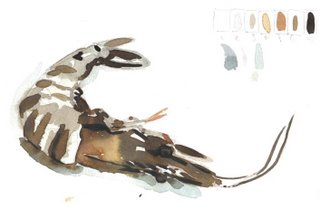
This is my demonstration of a prawn in watercolour.
On the top right you can see the colour-chart of light to dark tones.
Step one, they use the pencil to outline the subject. Where the white hightlight is concerned, no white paint is used; just leave the paper white, painting in only those of colour.
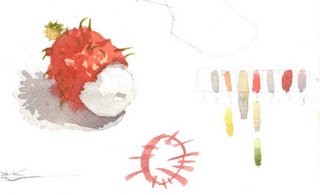
This is my demonstration of a rambutan in watercolour.
On the side you can see the colour- chart of light to dark tones.
Step two, I would ask them to mix the brighter colour which is only a little darker than the paper-white colour. After painting it on, we will mix the third colour which is darker than the second one.
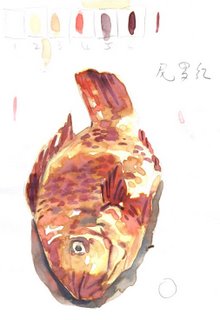
This is my demonstration of a fish in watercolour.
On the top you can see the colour-chart of light to dark tones.
These two steps, from light to dark, are easy to master. Whenever I see them using this technique to get a good painting effect, I feel very happy.
 Study on Crab
Study on CrabNote the 'one-layer' technique on the claw.
I think that one great thing in teaching is the satisfaction. When you see them learning the technique, knowing how to handle the technique, and able to master the technique to the standard that you set, the satisfaction is great and you feel really happy. I am happy to see their satisfied expressions too. This reminds me of my Heavenly Father who is pleased to bless me, and when He sees I am happy, it brings Him great joy also.

Study on Salmon Head - view 3
Note: If you do not know how to paint in watercolour, it does not mean that you can't learn oil-painting. Some people have the wrong impression that - before you learn oil-painting, you have to learn watercolour first, or you would face a lot of difficulties in oil painting.
This is actually the wrong impression, because the two techniques are very different. While watercolouring is from light to dark, oil-painting is from dark to light. So in the future, if you hear someone say that you have to master watercolour first before oil painting, you must tell them, "No! You are wrong! But Relax... " :)







 A Boring Picture #01, 1990 (courtesy of Singapore Art Museum)
A Boring Picture #01, 1990 (courtesy of Singapore Art Museum) A Boring Picture #07, 1990 (courtesy of Singapore Art Museum)
A Boring Picture #07, 1990 (courtesy of Singapore Art Museum)






















